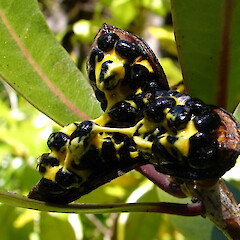Pittosporum kirkii
Common name
Kirk’s kōhūhū, thick-leaved kohukohu
Synonyms
None
Family
Pittosporaceae
Flora category
Vascular – Native
Endemic taxon
Yes
Endemic genus
No
Endemic family
No
Structural class
Trees & Shrubs - Dicotyledons
NVS code
The National Vegetation Survey (NVS) Databank is a physical archive and electronic databank containing records of over 94,000 vegetation survey plots - including data from over 19,000 permanent plots. NVS maintains a standard set of species code abbreviations that correspond to standard scientific plant names from the Ngä Tipu o Aotearoa - New Zealand Plants database.
PITKIR
Chromosome number
2n = 24
Current conservation status
The conservation status of all known New Zealand vascular plant taxa at the rank of species and below were reassessed in 2017 using the New Zealand Threat Classification System (NZTCS) – more information about this can be found on the NZTCS website. This report includes a statistical summary and brief notes on changes since 2012 and replaces all previous NZTCS lists for vascular plants.
Please note, threat classifications are often suggested by authors when publications fall between NZTCS assessment periods – an interim threat classification status has not been assessed by the NZTCS panel.
- Conservation status of New Zealand indigenous vascular plants, 2017 . 2018. Peter J. de Lange, Jeremy R. Rolfe, John W. Barkla, Shannel P. Courtney, Paul D. Champion, Leon R. Perrie, Sarah M. Beadel, Kerry A. Ford, Ilse Breitwieser, Ines Schönberger, Rowan Hindmarsh-Walls, Peter B. Heenan and Kate Ladley. Department of Conservation. Source: NZTCS and licensed by DOC for reuse under the Creative Commons Attribution 4.0 International licence.
2017 | At Risk – Declining | Qualifiers: DP, PD
Previous conservation statuses
2012 | At Risk – Declining | Qualifiers: DP
2009 | At Risk – Declining | Qualifiers: DP
2004 | Serious Decline
Brief description
Shrub often growing on other trees and bearing narrow leathery thick leaves that are widest towards the tip and with flattened hard capsules. Leaves 5-10cm long by 2-3cm wide. Flowers yellow, in cluster at tip of twigs. Fruit 2.5-4cm long, splitting into two showing the black seeds in yellow pith.
Distribution
Endemic to the northern half or the North Island, from Karikari Peninsula south of the northern reaches of the Whanganui River and west to Taranaki Mounga (Mt Egmont National Park).
Habitat
Usually epiphytic, rarely terrestrial in coastal to montane forest.
Detailed description
A small, gynodioecious, openly-branched shrub to 4 m tall with stout, purplish branches. Leaves are crowded towards the tips of the branch on 10 mm long stalks. The leaf blade is thick and fleshy, and broadens towards a rounded tip; leaves are 50–100 mm long by 20–30 mm wide. Flowers are either solitary or in clusters of up to four at the tips of branches, bright yellow and appear in November. Fruit are oval, woody capsules up to 40 mm long that split in half to reveal black seeds sitting in yellow sticky pulp, and appear in January.
Similar taxa
Pittosporum cornifolium, another epiphyte, has leaves that are usually shorter, broader and much thinner, and the inside of the capsules are shiny and bright orange. Kirk’s kohuhu could also be confused with Kirks tree daisy (Brachyglottis kirkii var. kirkii) but that species has white daisy-like flowers and dandelion-like wind-borne seeds.
Flowering
October to December
Flower colours
Yellow
Fruiting
January to May
Propagation technique
Easy from fresh seed. Can also be grown from semi hardwood cuttings but slow to strike.
Threats
Forest clearance, possum browse.
Etymology
pittosporum: Pitch seed
kirkii: After Thomas Kirk (18 January 1828 - 8 March 1898), a NZ botanist and lecturer in natural sciences and regarded as a leader of botanical enquiry in NZ for over three decades. One of his most significant publications was Forest flora of NZ (1889) but he also contributed over 130 papers to the Transactions and Proceedings of the NZ Institute and other journals.
Attribution
Fact sheet prepared for NZPCN by P.J. de Lange 30 August 2006. Description adapted from Cooper (1956).
References and further reading
Cooper, R.C. 1956: The Australian and New Zealand species of Pittosporum. Annals of the Missouri Botanical Garden 43: 87-188
NZPCN Fact Sheet citation
Please cite as: de Lange, P.J. (Year at time of access): Pittosporum kirkii Fact Sheet (content continuously updated). New Zealand Plant Conservation Network. https://www.nzpcn.org.nz/flora/species/pittosporum-kirkii/ (Date website was queried)






















